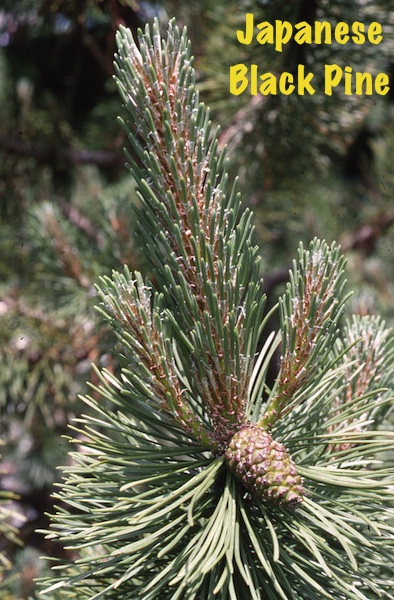Pine (Pinus sp.)
Pines offer some of the finest ornamental needled evergreen trees for civic and residential landscapes. Most pines are trees, often very large trees; but some are shrubs. Pines offer a variety of forms, needle structures, color from blue to dark green and texture from fine to coarse. Many landscape effects can be created with numerous cultivars. Pines can be used for windbreaks, accent trees or even foundation plantings.
 Pine trees are called conifers, because they bear cones. They grow throughout the northern temperate regions, from the seashore all the way to timberline in the mountains. Pines are divided into groups according to the number of needles --5, 3 or 2-- bundled together on their branches. Also, they are divided into “soft” and “hard” pine groups. Pines are important not only for their ornamental value but also for lumber, watershed management, resin, turpentine and Christmas trees. There are over 100 species of the genus Pinus recognized worldwide, of which 36 are native to the United States.
Pine trees are called conifers, because they bear cones. They grow throughout the northern temperate regions, from the seashore all the way to timberline in the mountains. Pines are divided into groups according to the number of needles --5, 3 or 2-- bundled together on their branches. Also, they are divided into “soft” and “hard” pine groups. Pines are important not only for their ornamental value but also for lumber, watershed management, resin, turpentine and Christmas trees. There are over 100 species of the genus Pinus recognized worldwide, of which 36 are native to the United States.
Pines have interesting background stories. Certainly that oldest of the pines is the Bristlecone Pine (Pinus aristata). The oldest specimens of this interesting tree are more than 4,000 years old. Egypt’s pyramids were under construction when these trees were seedlings! Pines played a big role in early U.S. history. In colonial times, Eastern White Pines above 24 inches in diameter were reserved by the English government to be used as ships masts. These trees were identified by blazing a broad arrow on the trunk. Because of the colonists general dislike of British rule, this "broad arrow" policy was one more source of friction between the two countries.
For those of us who adore basil pesto, certain pine trees give us edible pine nuts which are an essential ingredient in that special elixir. Unfortunately most landscape type pines produce small seeds that are not considered suitable as a food. The pines that produce seed the size of sunflower seed or larger are considered to be edible nut pines. Dried and toasted, they have a delicious nutty flavor. The species that is used in the landscape and can produce edible pine nuts is the Swiss Stone Pine You must be patient since the tree does not produce cones for at least eight to ten years.

